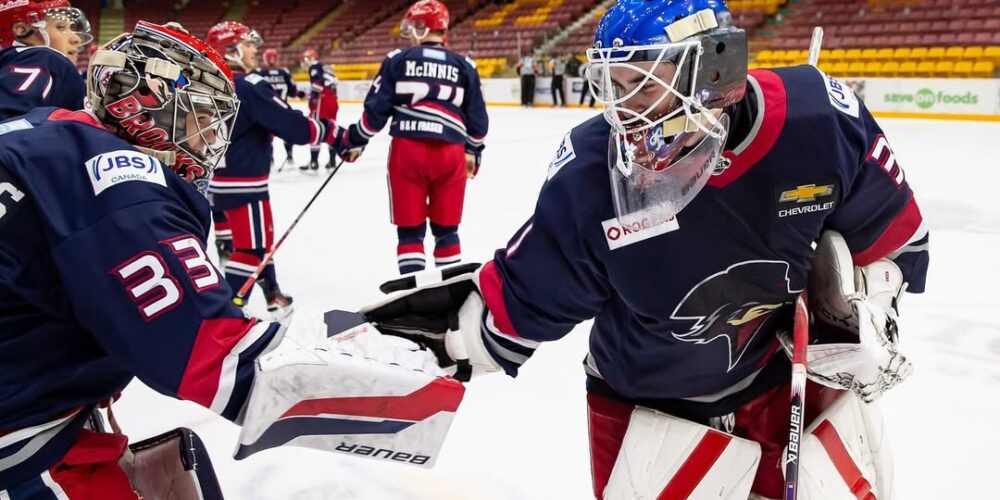The BCHL season begins Friday, and with it comes the first real look at how the league’s new roster regulations will shape lineups. The changes represent a notable shift in how teams are constructed. Gone are last year’s quotas tied to “branch” roots and passport categories. In their place are simpler nationality rules and more explicit requirements to get younger players into lineups.
If last year’s roster regulations felt like an attempt to preserve balance between tradition and independence, this year’s is more streamlined, leaning into clarity and flexibility. But underneath the cleaner language are some new restrictions that will test coaches and general managers in different ways.
A cleaner nationality rulebook
Last season, roster-building kind of came down to paperwork. Teams had to hit several overlapping targets:
- Five players with demonstrable roots to a regional “branch” (British Columbia, Alberta, Yukon, Northwest Territories, or Nunavut). A branch was defined as the athlete being born in-branch or having played youth hockey in-branch for at least three of the past five years.
- Thirteen players with demonstrable roots in the country where the team is based.
- A maximum of 10 Americans.
- A maximum of four players from outside North America.
The system was clunky, and in some cases forced teams into late-summer roster gymnastics to stay compliant. For 2025–26, the BCHL has stripped it back.
Now, every team must roster a minimum of 10 Canadians. The rest of the lineup – whether Americans or players from Europe and beyond – is wide open.
It’s not a minor shift. In one stroke, the BCHL has eliminated caps on American players, scrapped the branch quota, and lifted the restriction on non-North American players. For a league increasingly positioning itself as a direct competitor to U.S. junior leagues, it’s a significant pivot. The message is clear: recruit the best players you can, wherever they come from, just make sure at least 10 of them are Canadian.
Veterans vs. youth
The 20-year-old rules have also been adjusted. A year ago, teams could dress seven 20-year-olds, with up to 10 eligible to play over the course of a season. This year, the limit is eight, with an additional 20-year-old goaltender exempt from the total.
It’s not a massive change, but it does give coaches and GMs a bit more breathing room. 20-year-olds are often key contributors – captains, power-play quarterbacks, top-line centres, number-one goaltenders – and increasing the cap by one helps reduce the churn of moving veterans in and out to fit eligibility.
At the same time, the league has introduced firmer safeguards for younger players. Teams must carry a minimum of four rookies, who are defined as players with less than 30 games played at a similar junior level. To access the maximum 26-player roster, at least two skaters must be born between 2007 and 2009. And there’s no ceiling on 16-year-olds – meaning a team that wants to lean heavily into youth development is free to do so.
The rookie mandate might be the most consequential change. It ensures that every roster will feature first-year players, not just as extra bodies, but as permanent parts of the team. For a league that’s selling itself as a development platform, that kind of baked-in opportunity matters.
The goalie wrinkle
The BCHL has also tied roster size to goalie count. Teams carrying three goaltenders can expand to 26 players. Those with two netminders on their roster are capped at 25 total players.
It’s a strange wrinkle on paper, but it underlines how valuable goalie depth is – both for teams and for NCAA recruiters watching them. The league has essentially incentivized teams to keep a third goaltender around, which could lead to more younger netminders getting roster spots they wouldn’t have under a flat cap.
What it means for teams
For teams with the resources and recruiting networks to pull players from prep schools and European junior systems, the loosening of nationality rules could be a windfall. There’s no artificial ceiling on U.S. talent anymore. A team could – in theory – ice a lineup with half its roster drawn from New England prep school hockey or Minnesota high schools, so long as the 10-Canadian minimum is met.
For smaller-market teams, the changes are more double-edged. On one hand, there’s more freedom. On the other hand, the competition for top Canadian recruits could tighten if powerhouse clubs decide to fill their domestic quota with elite Canadians, then go shopping in the U.S. or overseas for the rest.
The rookie mandate will also change roster dynamics. Teams aren’t able to stash their 16- and 17-year-olds in peripheral roles all season. At least four of them will need to be dressed and involved, forcing coaches to juggle development and results more deliberately.
The bigger picture
The BCHL’s independence has always been about player flexibility. By leaving Hockey Canada in 2023, the league gave itself the ability to reshape its own rules to better align with its identity as an NCAA feeder. This year’s roster framework feels like another step down that path.
There’s less red tape, fewer artificial barriers, and more emphasis on development. But it also tilts the league further away from its roots as a provincial circuit and deeper into the role of an international showcase.
When the puck drops Friday night, fans will see the first test of these new regulations. Some teams will look younger. Some will lean heavier on American recruits. And some may gamble on carrying that extra goalie to squeeze in one more skater.
The regulations won’t decide games. But they will decide who gets on the ice – and in junior hockey, that’s often just as important.
Photo credit: Garrett James Photography



